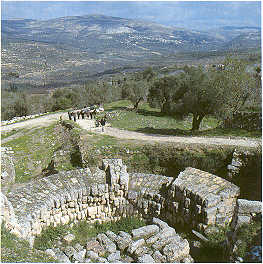
Nablus
Between Mount Garizim and Mount Ebal lies Nablus (the Uncrowned Queen of Palestine) 63 km north of Jerusalem. The town is located in an area that has an abundant water supply. Its gardens and fields are irrigated from 16 natural springs. Nablus is considered to be the largest city in the West Bank outside Jerusalem and has become one of the main Palestinian centers of industry and commerce with a busy market, soap factories and goldsmiths, etc. The city is famous for its sweets.
Old Town of Nablus
The Old Town of Nablus is a large residential and market area featuring many
old buildings and lively street scenes and activities. There are impressive
mosques, souqs, Turkish baths and traditional olive oil soap factories. It is
well worth exploring.
Jacob's Well
The 35 meter deep well stands in the land that Jacob bought from Hanor for "a
hundred pieces of silver" (Genesis 33: 19). It is also here that Jesus
asked a Samaritan woman to draw water for him to drink. The well has been an
object of pilgrimage since then.
Tell Balata
Tell Balata is situated 3 km east of Nablus. The extensive remains relate to
the town that was built around 1700 BC. The city was founded by the Canaanites
and since then it has been destroyed and rebuilt several times.
Sabastia
12 km northwest of Nablus up on the scenic slopes of the Nablus hills stands
the village of Sabastia. On top of the hill the remains of an Iron Age city
were found. Inside the village lies a Crusader's Church (12th century), which
was converted into a mosque with two tomb chambers. The head of john the Baptist
is believed to be buried here.

Burqin Church
The village of Burqin is located 3 km west of Jenin. The church lies on the
northern slope of the hill overlooking Wadi Burqin. The church is still used
by the Christian Greek Orthodox community of the village. Tradition suggests
that Jesus, on his way to Jerusalem, passed by the village and miraculously
healed the lepers there.
This delightful small church has been restored several times through the centuries.
The first church was in the cave where the miracle took place, while during
the 6th -9th century it was extended in front of the cave. The church was then
rebuilt during the 12th century and enclosed by a wall. The present church comprises
the cave and the new hall and nave built during the 18th century .